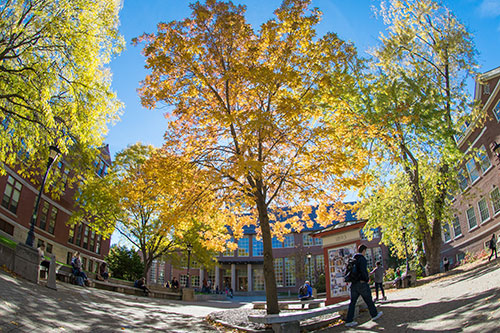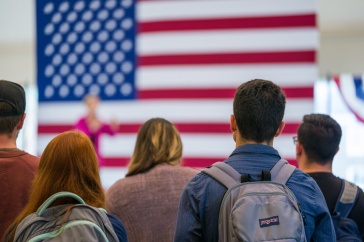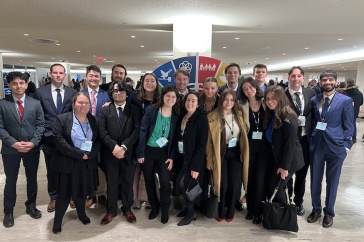
Across the country this week, universities and colleges are celebrating Constitution Day, an annual commemoration of the signing of the U.S. Constitution on Sept. 17, 1787, by the 39 delegates to the Constitutional Convention in Philadelphia. Here, UNH associate professor of political science Susan Siggelakis reflects on Puerto Rico v. Sánchez Valle, a case that went before the Supreme Court of the United States earlier this year, putting the justices, the 229-year-old Constitution and its Fifth Amendment to the test.
Share your thoughts on the Constitution using the hashtag #ConstitutionDay.
One of the U.S. Supreme Court’s cases handed down at the end of its June 2016 term illustrates how our 227-year-old Constitution still provides a useful framework for deciding questions that the founders of our republic never dreamed about.
One of the due process rights, the Fifth Amendment right to be free from double jeopardy, was incorporated into the due process clause of the 14th Amendment in 1969 in the case of Benton v. Maryland. In its simplest terms, the double-jeopardy clause establishes that a person cannot face two criminal trials and separate punishments for the same transaction. Seems simple enough, right? But complexities arise, for example, when the same criminal conduct makes a person liable for prosecution by different governments — for example, drug trafficking can make one open to prosecution by a state government as well as the federal government because, as the court has held, they are “separate sovereigns.” The source of each government’s authority is distinct — for New Hampshire, the source of the authority is the people of New Hampshire; for the federal government, the source is the people of the United States.

Susan Siggelakis teaches POLT 508, Supreme Court and the Constitution, and other classes in the department of political science.
But is a U.S. territory, specifically Puerto Rico, a separate sovereign for purposes of double jeopardy? This was a question the U.S. Supreme Court had to try and answer when two men in Puerto Rico (remember, Puerto Rican citizens are U.S. citizens) each sold a gun to an undercover police officer. Both men were indicted by Puerto Rican prosecutors for violating the terms of the Puerto Rican Arms Act of 2000. While those charges were pending, a grand jury indicted them for violating an analogous federal gun trafficking statute to which they plead guilty. Were the federal charges a violation of their right to be free from double jeopardy given that Puerto Rico had charges pending against them for the same incident? The Puerto Rican Supreme Court said that it was. A lower federal court ruled that it was not. The Supreme Court reversed, holding that the parallel charges did violate guarantees against double jeopardy.
Not only that, the court held that for purposes of double jeopardy, Puerto Rico was not a separate sovereign. For those of you who are a bit vague on the history, Puerto Rico became a territory of the U.S. in 1898 as a result of the treaty concluding the Spanish American War. Congress was obliged under the treaty to determine “the civil rights and political status” of its inhabitants and established a civil government. It was empowered to do so by Article IV of the U.S. Constitution: “The Congress shall have power to dispose of and make all needful rules and regulations respecting the Territory … of the United States.” Congress passed a statutory law delegating important powers, including judicial powers, to Puerto Rico. Puerto Rico has since evolved into a constitutional democracy that exercises local self-rule.
This is not an easy case. If Puerto Rico was determined to be a separate sovereign, then both prosecutions were legal and no double jeopardy had occurred. If Puerto Rico was not determined to be a separate sovereign, then Puerto Rico’s prosecution would be barred as duplicating the United States’ prosecution, a double-jeopardy violation.
Before they could address the double-jeopardy question, the justices had to answer a deeper question, one that transcended the written texts of both firearm statutes and the Constitution itself: “What does it mean to be a sovereign state?” Normally this is a question better asked of political philosophers or specialists in international affairs than federal judges and one to which no answer is given in the U.S. Constitution.
The Supreme Court determined that for purposes of the double-jeopardy clause, Puerto Rico is not a “sovereign.” The vote was 7-2. Both the majority and the dissent exhaustively reviewed 20th-century history of relations between the U.S. and Puerto Rico, including relevant legal statutes, the U.S. government’s treatment of comparable entities such as Indian tribes, territories and states, presidential papers, treaties, memos from the U.S. Department of Justice, resolutions of the United Nations and decisions of the Puerto Rican Supreme Court. Among many questions, the justices asked: What precedents do we have both with Indian tribes, states and other territories that might help us answer this question? How has Congress treated Puerto Rico in the intervening decades? What longstanding practices, understandings and relationships might help us figure out their status?

Interested in studying political science in one of the nation’s busiest political hotbeds? Come to UNH.
The justices acknowledged that a number of ways existed to ascertain sovereignty; for example, the degree to which a country is autonomous from any other in the exercise of certain functions. But both sides rejected that approach, employing instead a historical lens — that is, trying to determine the origin of the sovereignty, or as they put it, the “wellspring.” In the end, a majority of the court’s justices, led by Associate Justice Elena Kagan, chose to rest its conclusion on its determination of the “wellspring” of the sovereignty, locating it in the Congress of the United States. In dissent, Associate Justices Stephen Breyer and Sonia Sotomayor argue that the source of the sovereignty was indeed Congress but that, during the past century, the original act of Congress has COMBINED with subsequent statutes, organic acts, traditions, statements and other actions in such a way as to render the island nation’s people the source of its sovereign authority. The result of the majority opinion was that the decision of the Puerto Rico Supreme Court was affirmed and the petitioners’ claim that they had been exposed to double jeopardy was vindicated.
As one can see, this case shows how our Constitution remains a vibrant source of law, helping resolve questions that the founders could not have imagined. The text of the Constitution provides the raw materials for this legal dispute — we have the double-jeopardy clause as the source of the claim and we have the Article IV authorization of Congress to regulate the territories. Yet, the constitutional answer to this question — yes, the defendants were deprived of their constitutional right to be free from double jeopardy — rests on the justices’ assumptions, inferences, logic, methodologies and interpretation of the evidence in light of the text of the Constitution. Not everyone on the court will see those in the same way, of course. Were the framers of the 18th century able to anticipate this particular scenario? Certainly not. But, as this case illustrates, they did frame a constitutional text that establishes baseline principles and protections for the individual from which our government cannot depart, despite the myriad changes that have occurred in our nation since 1787.

















































